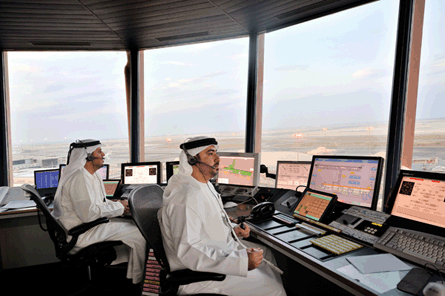Eight years after the implementation of reduced vertical separation minima (RVSM) across the Middle Eastern region, the missing piece of the puzzle slotted into place.
When the Middle East, in 2003, adopted RVSM - the halving of adjacent cruise altitude spacing to 1,000ft (305m), to provide additional capacity - the conflict in Iraq meant the Baghdad flight information region was omitted from the initiative.
 |
|---|
© Abu Dhabi Airports Improved Middle Eastern airspace efficiency is the target of several new initiatives |
Controllers handling aircraft which were permitted to cross Iraqi airspace - rather than weave a course around the country's border - were forced to redistribute them across an antiquated airspace structure. Flights entering Iraqi airspace at 10 different altitudes had to be re-allocated to just five, a co-ordination task made more difficult by affected flights asking to stay at least at 30,000ft.
IATA had pressed for several years to bring Iraq into line, to resolve the traffic flow problem and cut out inefficiency - and after a proposed switch in November 2010 passed without result, Iraq finally implemented RVSM on 10 March.
Restructuring Baghdad's flight information region is just one crucial step in the effort to improve Middle Eastern airspace efficiency. Not only is the area a crucial crossing point for en route operations, but the size of the Arab air transport market is set to increase some 2.5 times - to more than 300 million passengers - by 2019, according to the Arab Air Carriers Organisation (AACO).
Several specific problems need addressing, AACO adds. There is a lack of domestic airways for international traffic flow, and traffic flow is concentrated on just a few routes. New traffic flows emerging over the last 10 years have not been taken into account, and there has been little rationalisation of airspace to make it independent of national borders - all coupled with a failure to consider all airspace as a possible resource.
"Current constraints limit capacity and force inefficient routings," the Civil Air Navigation Services Organisation (CANSO) told the inaugural meeting of Middle Eastern directors general earlier this year. "The route structure does not currently make use of the advanced navigation capability of modern airline fleets, [and] civil and military airspace sharing agreements are needed to better balance airspace distribution."
CANSO is heading an initiative known as MIDRAR, which intends to identify and resolve bottlenecks. The status of progress on capacity actions will be disclosed during a meeting in Amman in November. It will concentrate on seven airspace areas - Amman, Bahrain, Cairo, Jeddah, Muscat, Syria and the United Arab Emirates - and CANSO indicates that the measures will include harmonisation of separation standards, along with the realignment and segregation of route structures.
"We're trying to find the best solution that is supported by all stakeholders. We're very much concentrating on getting everybody into the bag," MIDRAR vice-chair Mahmoud Ghaben told Flight International, adding that such agreement is "essential".
ECONOMIC SENSE
Ghaben believes that political sensitivities in the region will not be among the hurdles facing the scheme, because states "understand the importance [of aviation] to drive the economy", adding: "It's not a political constraint and it won't affect progress."
But MIDRAR must co-ordinate its plans not just within the Middle East but also regionally, to ensure seamless links with Europe and the east. "We don't want to come up with separate plans," says Ghaben.
Separation standards have already been revised in several Arab states. Since July 2010 there has been 37km (20nm) longitudinal separation between Bahrain, Jordan, Saudi Arabia and Syria, and more recently this has extended to Kuwait, Iraq and Turkey, while Bahrain's authorities have requested a further cut to 19km in order to cater for traffic projections.
Under MIDRAR, concepts such as flexible use of airspace will be considered to handle the thorny civil-military issue, says Ghaben, along with initiatives centred on performance-based navigation. The scheme will aim for "quick wins", as well as longer-term measures.
Performance-based navigation is a key part of the optimisation strategy for Middle Eastern en route airspace. Implementation of area navigation, to RNP 5 (5nm) accuracy, between flight levels 160 and 460, is the subject of close monitoring in the Middle Eastern region, and there is encouragement for states to take this further by increasing the accuracy to RNP 1, not only in en route but also in terminal airspace.
Bahrain, Oman and the UAE in particular have used RNP 1 to alleviate areas of congestion.
ICAO is also coaxing civil aviation authorities in the area to introduce continuous descent operations within their terminal airspace, as part of this performance-based navigation strategy. Continuous descent minimises the number of changes to thrust settings during approach, and provides a simpler, more efficient flightpath between cruise and touchdown.
Source: Flight International



















